Leadership for Corporate Social Responsibility and Sustainability
VerifiedAdded on 2023/04/08
|12
|2453
|488
Report
AI Summary
This report delves into the critical intersection of leadership, Corporate Social Responsibility (CSR), and sustainability within strategic management, particularly in the context of the 21st century. It begins by defining leadership and its core components, emphasizing its vital role in guiding organizations and individuals. The report then explores the close relationship between leadership and CSR, highlighting the challenges leaders face in a global environment marked by ambiguity and the need for sustainable practices. The discussion covers the role of leadership in implementing CSR, addressing ethical dilemmas, and fostering a sustainable society. Furthermore, the report examines sustainability issues in strategic management, defining sustainability and sustainable business practices. It outlines key practices such as stakeholder engagement, environmental management systems, reporting, and life cycle analysis. The analysis then identifies sustainability issues in the 21st century, including the impact of new technologies and the need for innovation. The report concludes by suggesting that breakthrough innovation focused on sustainability is essential to address these issues and achieve long-term success.
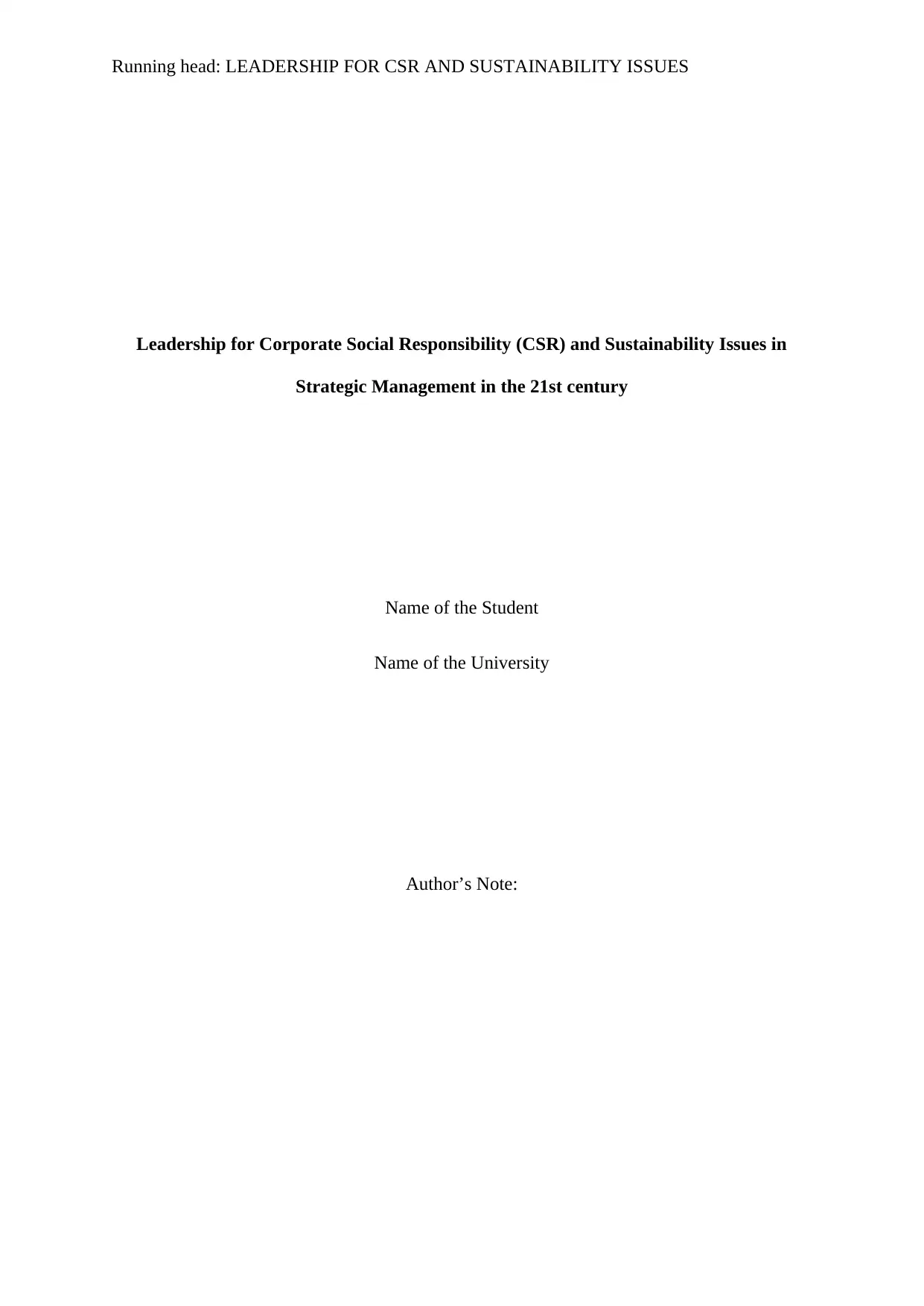
Running head: LEADERSHIP FOR CSR AND SUSTAINABILITY ISSUES
Leadership for Corporate Social Responsibility (CSR) and Sustainability Issues in
Strategic Management in the 21st century
Name of the Student
Name of the University
Author’s Note:
Leadership for Corporate Social Responsibility (CSR) and Sustainability Issues in
Strategic Management in the 21st century
Name of the Student
Name of the University
Author’s Note:
Paraphrase This Document
Need a fresh take? Get an instant paraphrase of this document with our AI Paraphraser
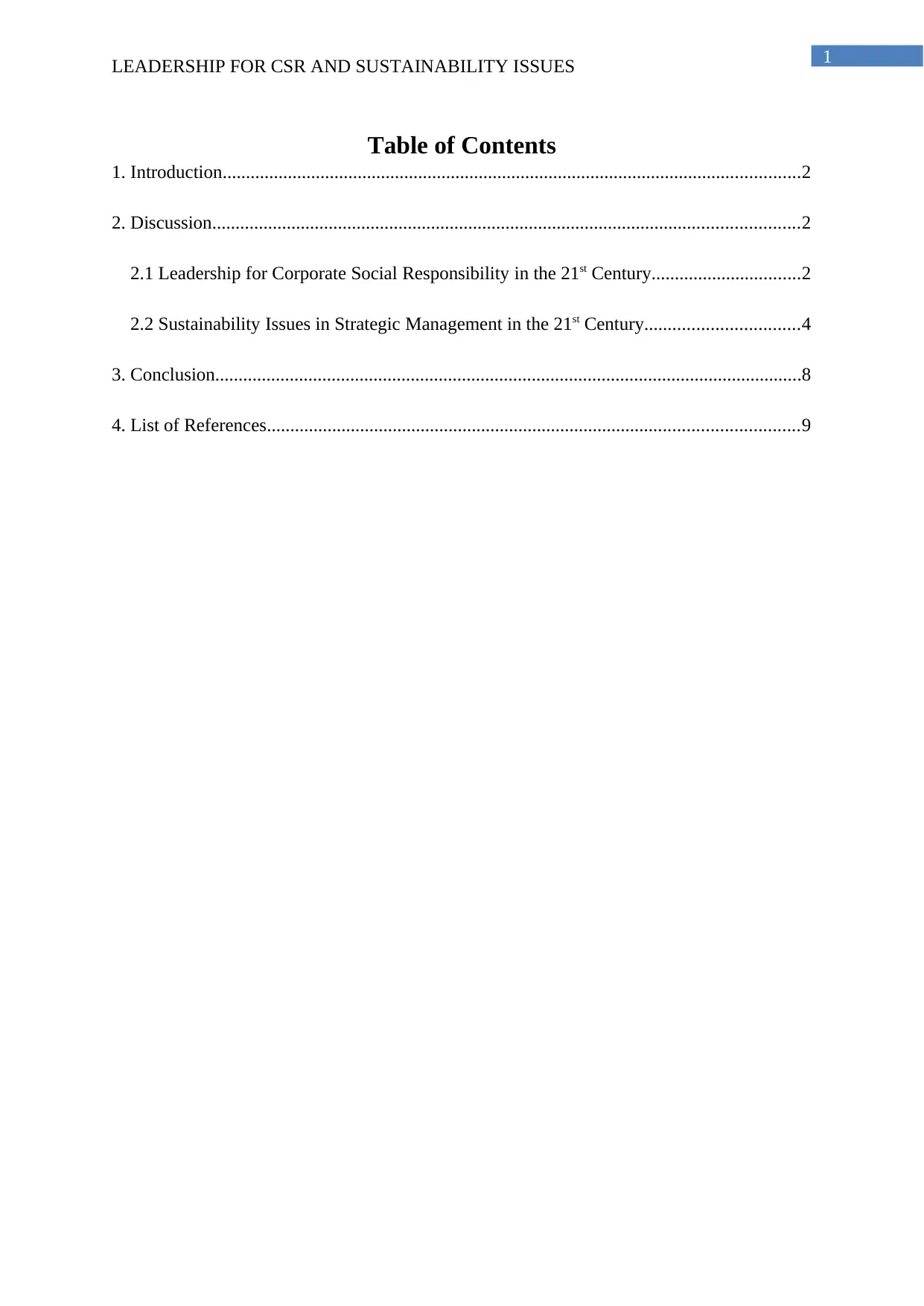
1
LEADERSHIP FOR CSR AND SUSTAINABILITY ISSUES
Table of Contents
1. Introduction............................................................................................................................2
2. Discussion..............................................................................................................................2
2.1 Leadership for Corporate Social Responsibility in the 21st Century................................2
2.2 Sustainability Issues in Strategic Management in the 21st Century.................................4
3. Conclusion..............................................................................................................................8
4. List of References..................................................................................................................9
LEADERSHIP FOR CSR AND SUSTAINABILITY ISSUES
Table of Contents
1. Introduction............................................................................................................................2
2. Discussion..............................................................................................................................2
2.1 Leadership for Corporate Social Responsibility in the 21st Century................................2
2.2 Sustainability Issues in Strategic Management in the 21st Century.................................4
3. Conclusion..............................................................................................................................8
4. List of References..................................................................................................................9
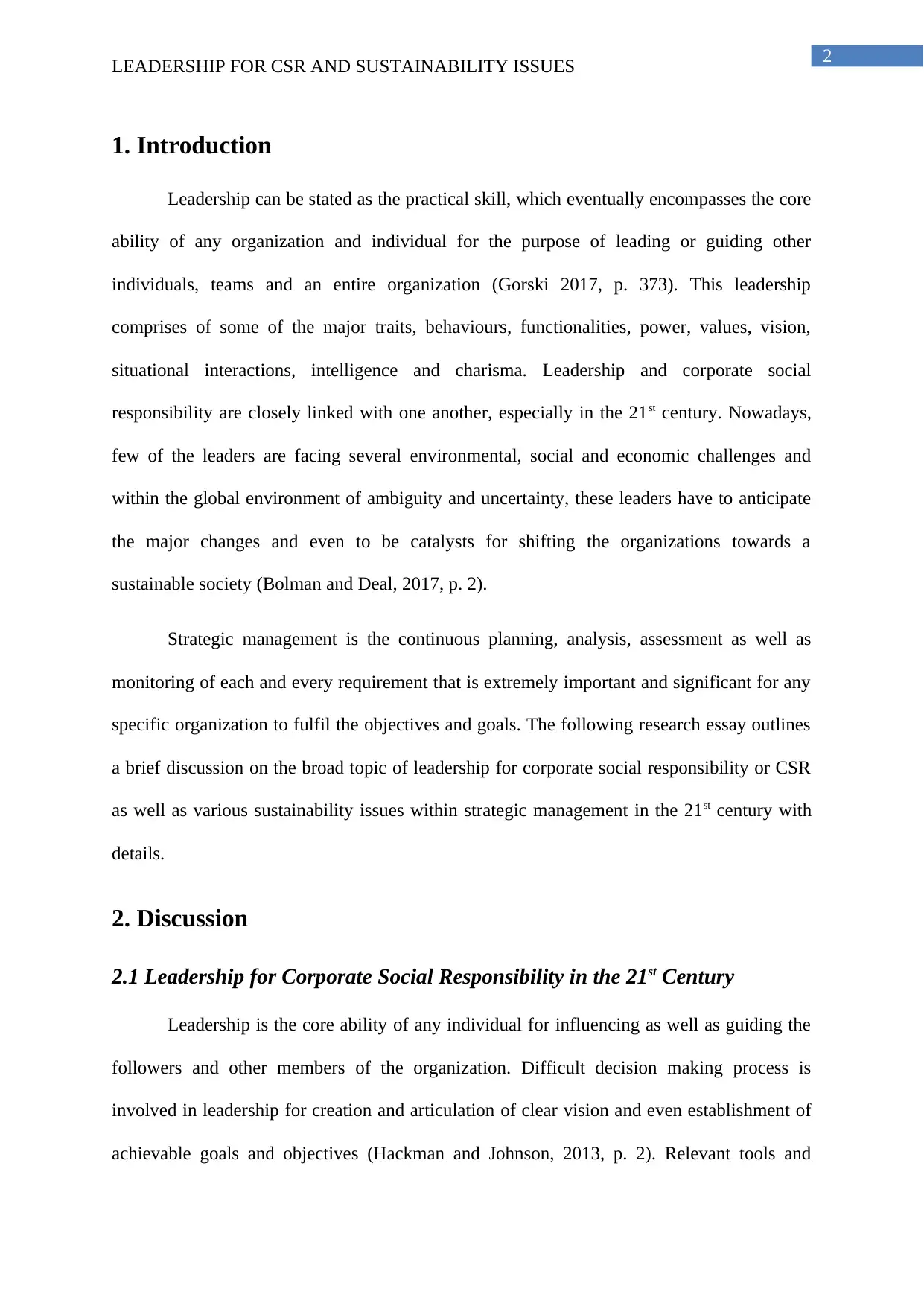
2
LEADERSHIP FOR CSR AND SUSTAINABILITY ISSUES
1. Introduction
Leadership can be stated as the practical skill, which eventually encompasses the core
ability of any organization and individual for the purpose of leading or guiding other
individuals, teams and an entire organization (Gorski 2017, p. 373). This leadership
comprises of some of the major traits, behaviours, functionalities, power, values, vision,
situational interactions, intelligence and charisma. Leadership and corporate social
responsibility are closely linked with one another, especially in the 21st century. Nowadays,
few of the leaders are facing several environmental, social and economic challenges and
within the global environment of ambiguity and uncertainty, these leaders have to anticipate
the major changes and even to be catalysts for shifting the organizations towards a
sustainable society (Bolman and Deal, 2017, p. 2).
Strategic management is the continuous planning, analysis, assessment as well as
monitoring of each and every requirement that is extremely important and significant for any
specific organization to fulfil the objectives and goals. The following research essay outlines
a brief discussion on the broad topic of leadership for corporate social responsibility or CSR
as well as various sustainability issues within strategic management in the 21st century with
details.
2. Discussion
2.1 Leadership for Corporate Social Responsibility in the 21st Century
Leadership is the core ability of any individual for influencing as well as guiding the
followers and other members of the organization. Difficult decision making process is
involved in leadership for creation and articulation of clear vision and even establishment of
achievable goals and objectives (Hackman and Johnson, 2013, p. 2). Relevant tools and
LEADERSHIP FOR CSR AND SUSTAINABILITY ISSUES
1. Introduction
Leadership can be stated as the practical skill, which eventually encompasses the core
ability of any organization and individual for the purpose of leading or guiding other
individuals, teams and an entire organization (Gorski 2017, p. 373). This leadership
comprises of some of the major traits, behaviours, functionalities, power, values, vision,
situational interactions, intelligence and charisma. Leadership and corporate social
responsibility are closely linked with one another, especially in the 21st century. Nowadays,
few of the leaders are facing several environmental, social and economic challenges and
within the global environment of ambiguity and uncertainty, these leaders have to anticipate
the major changes and even to be catalysts for shifting the organizations towards a
sustainable society (Bolman and Deal, 2017, p. 2).
Strategic management is the continuous planning, analysis, assessment as well as
monitoring of each and every requirement that is extremely important and significant for any
specific organization to fulfil the objectives and goals. The following research essay outlines
a brief discussion on the broad topic of leadership for corporate social responsibility or CSR
as well as various sustainability issues within strategic management in the 21st century with
details.
2. Discussion
2.1 Leadership for Corporate Social Responsibility in the 21st Century
Leadership is the core ability of any individual for influencing as well as guiding the
followers and other members of the organization. Difficult decision making process is
involved in leadership for creation and articulation of clear vision and even establishment of
achievable goals and objectives (Hackman and Johnson, 2013, p. 2). Relevant tools and
⊘ This is a preview!⊘
Do you want full access?
Subscribe today to unlock all pages.

Trusted by 1+ million students worldwide
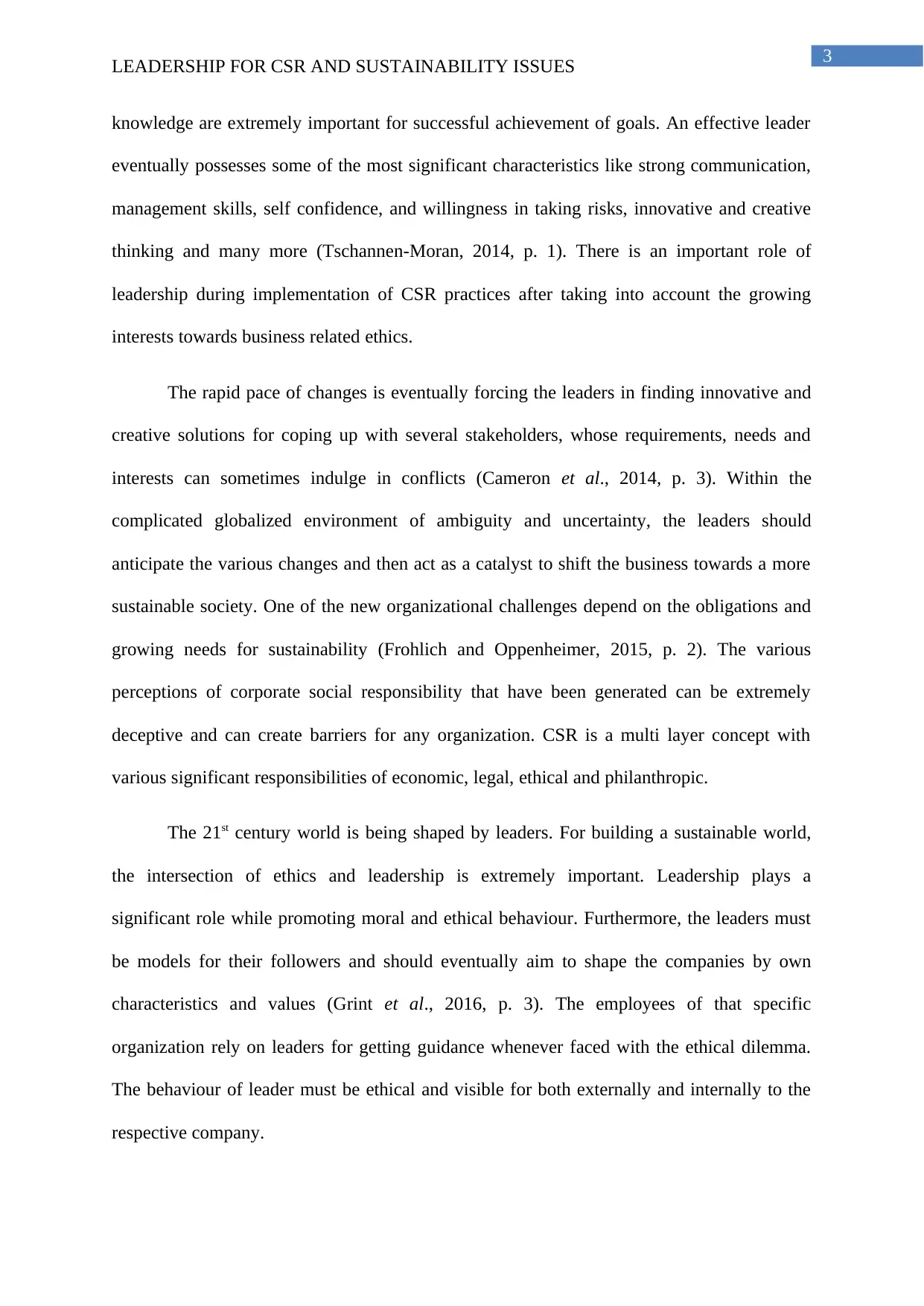
3
LEADERSHIP FOR CSR AND SUSTAINABILITY ISSUES
knowledge are extremely important for successful achievement of goals. An effective leader
eventually possesses some of the most significant characteristics like strong communication,
management skills, self confidence, and willingness in taking risks, innovative and creative
thinking and many more (Tschannen-Moran, 2014, p. 1). There is an important role of
leadership during implementation of CSR practices after taking into account the growing
interests towards business related ethics.
The rapid pace of changes is eventually forcing the leaders in finding innovative and
creative solutions for coping up with several stakeholders, whose requirements, needs and
interests can sometimes indulge in conflicts (Cameron et al., 2014, p. 3). Within the
complicated globalized environment of ambiguity and uncertainty, the leaders should
anticipate the various changes and then act as a catalyst to shift the business towards a more
sustainable society. One of the new organizational challenges depend on the obligations and
growing needs for sustainability (Frohlich and Oppenheimer, 2015, p. 2). The various
perceptions of corporate social responsibility that have been generated can be extremely
deceptive and can create barriers for any organization. CSR is a multi layer concept with
various significant responsibilities of economic, legal, ethical and philanthropic.
The 21st century world is being shaped by leaders. For building a sustainable world,
the intersection of ethics and leadership is extremely important. Leadership plays a
significant role while promoting moral and ethical behaviour. Furthermore, the leaders must
be models for their followers and should eventually aim to shape the companies by own
characteristics and values (Grint et al., 2016, p. 3). The employees of that specific
organization rely on leaders for getting guidance whenever faced with the ethical dilemma.
The behaviour of leader must be ethical and visible for both externally and internally to the
respective company.
LEADERSHIP FOR CSR AND SUSTAINABILITY ISSUES
knowledge are extremely important for successful achievement of goals. An effective leader
eventually possesses some of the most significant characteristics like strong communication,
management skills, self confidence, and willingness in taking risks, innovative and creative
thinking and many more (Tschannen-Moran, 2014, p. 1). There is an important role of
leadership during implementation of CSR practices after taking into account the growing
interests towards business related ethics.
The rapid pace of changes is eventually forcing the leaders in finding innovative and
creative solutions for coping up with several stakeholders, whose requirements, needs and
interests can sometimes indulge in conflicts (Cameron et al., 2014, p. 3). Within the
complicated globalized environment of ambiguity and uncertainty, the leaders should
anticipate the various changes and then act as a catalyst to shift the business towards a more
sustainable society. One of the new organizational challenges depend on the obligations and
growing needs for sustainability (Frohlich and Oppenheimer, 2015, p. 2). The various
perceptions of corporate social responsibility that have been generated can be extremely
deceptive and can create barriers for any organization. CSR is a multi layer concept with
various significant responsibilities of economic, legal, ethical and philanthropic.
The 21st century world is being shaped by leaders. For building a sustainable world,
the intersection of ethics and leadership is extremely important. Leadership plays a
significant role while promoting moral and ethical behaviour. Furthermore, the leaders must
be models for their followers and should eventually aim to shape the companies by own
characteristics and values (Grint et al., 2016, p. 3). The employees of that specific
organization rely on leaders for getting guidance whenever faced with the ethical dilemma.
The behaviour of leader must be ethical and visible for both externally and internally to the
respective company.
Paraphrase This Document
Need a fresh take? Get an instant paraphrase of this document with our AI Paraphraser
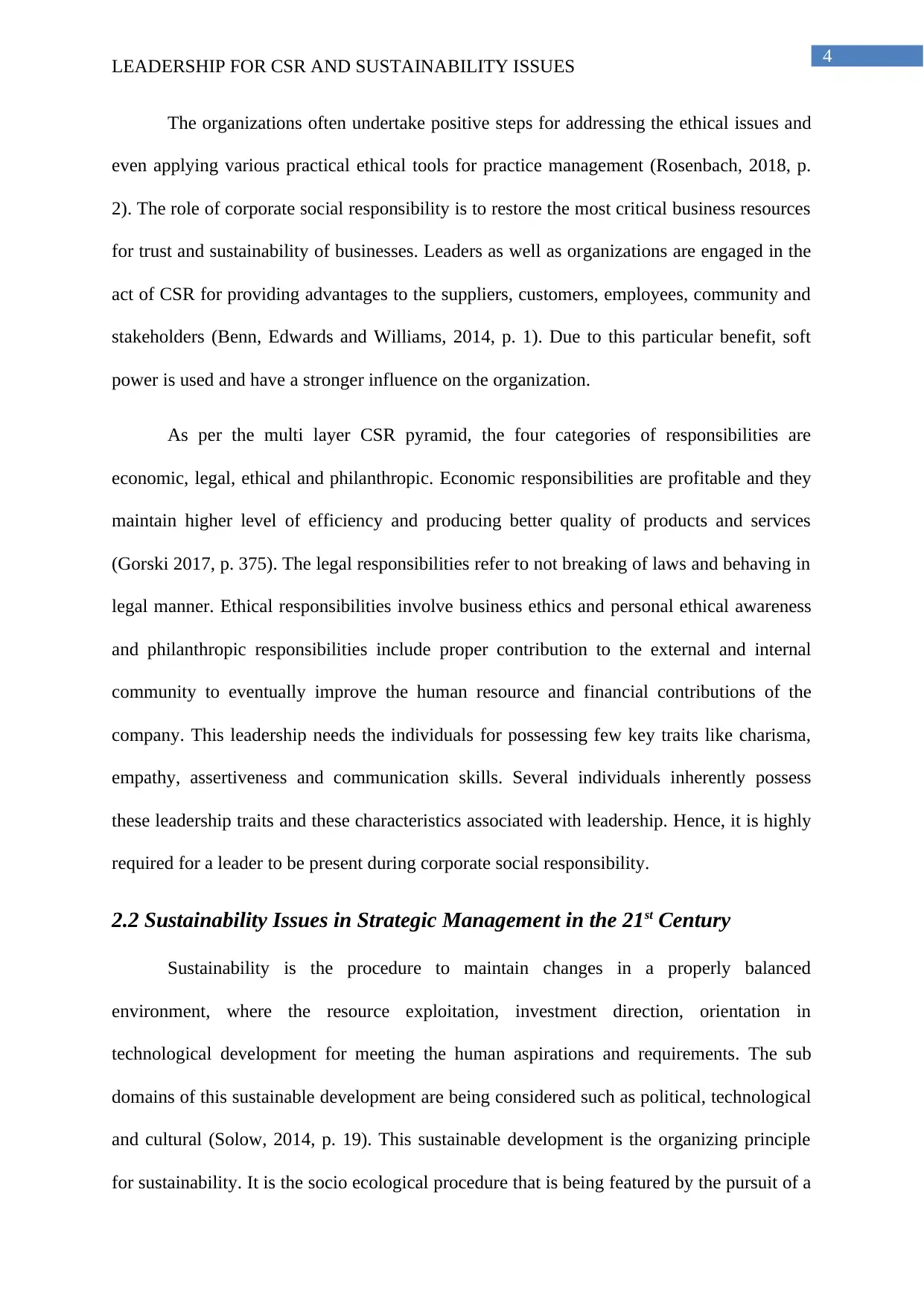
4
LEADERSHIP FOR CSR AND SUSTAINABILITY ISSUES
The organizations often undertake positive steps for addressing the ethical issues and
even applying various practical ethical tools for practice management (Rosenbach, 2018, p.
2). The role of corporate social responsibility is to restore the most critical business resources
for trust and sustainability of businesses. Leaders as well as organizations are engaged in the
act of CSR for providing advantages to the suppliers, customers, employees, community and
stakeholders (Benn, Edwards and Williams, 2014, p. 1). Due to this particular benefit, soft
power is used and have a stronger influence on the organization.
As per the multi layer CSR pyramid, the four categories of responsibilities are
economic, legal, ethical and philanthropic. Economic responsibilities are profitable and they
maintain higher level of efficiency and producing better quality of products and services
(Gorski 2017, p. 375). The legal responsibilities refer to not breaking of laws and behaving in
legal manner. Ethical responsibilities involve business ethics and personal ethical awareness
and philanthropic responsibilities include proper contribution to the external and internal
community to eventually improve the human resource and financial contributions of the
company. This leadership needs the individuals for possessing few key traits like charisma,
empathy, assertiveness and communication skills. Several individuals inherently possess
these leadership traits and these characteristics associated with leadership. Hence, it is highly
required for a leader to be present during corporate social responsibility.
2.2 Sustainability Issues in Strategic Management in the 21st Century
Sustainability is the procedure to maintain changes in a properly balanced
environment, where the resource exploitation, investment direction, orientation in
technological development for meeting the human aspirations and requirements. The sub
domains of this sustainable development are being considered such as political, technological
and cultural (Solow, 2014, p. 19). This sustainable development is the organizing principle
for sustainability. It is the socio ecological procedure that is being featured by the pursuit of a
LEADERSHIP FOR CSR AND SUSTAINABILITY ISSUES
The organizations often undertake positive steps for addressing the ethical issues and
even applying various practical ethical tools for practice management (Rosenbach, 2018, p.
2). The role of corporate social responsibility is to restore the most critical business resources
for trust and sustainability of businesses. Leaders as well as organizations are engaged in the
act of CSR for providing advantages to the suppliers, customers, employees, community and
stakeholders (Benn, Edwards and Williams, 2014, p. 1). Due to this particular benefit, soft
power is used and have a stronger influence on the organization.
As per the multi layer CSR pyramid, the four categories of responsibilities are
economic, legal, ethical and philanthropic. Economic responsibilities are profitable and they
maintain higher level of efficiency and producing better quality of products and services
(Gorski 2017, p. 375). The legal responsibilities refer to not breaking of laws and behaving in
legal manner. Ethical responsibilities involve business ethics and personal ethical awareness
and philanthropic responsibilities include proper contribution to the external and internal
community to eventually improve the human resource and financial contributions of the
company. This leadership needs the individuals for possessing few key traits like charisma,
empathy, assertiveness and communication skills. Several individuals inherently possess
these leadership traits and these characteristics associated with leadership. Hence, it is highly
required for a leader to be present during corporate social responsibility.
2.2 Sustainability Issues in Strategic Management in the 21st Century
Sustainability is the procedure to maintain changes in a properly balanced
environment, where the resource exploitation, investment direction, orientation in
technological development for meeting the human aspirations and requirements. The sub
domains of this sustainable development are being considered such as political, technological
and cultural (Solow, 2014, p. 19). This sustainable development is the organizing principle
for sustainability. It is the socio ecological procedure that is being featured by the pursuit of a
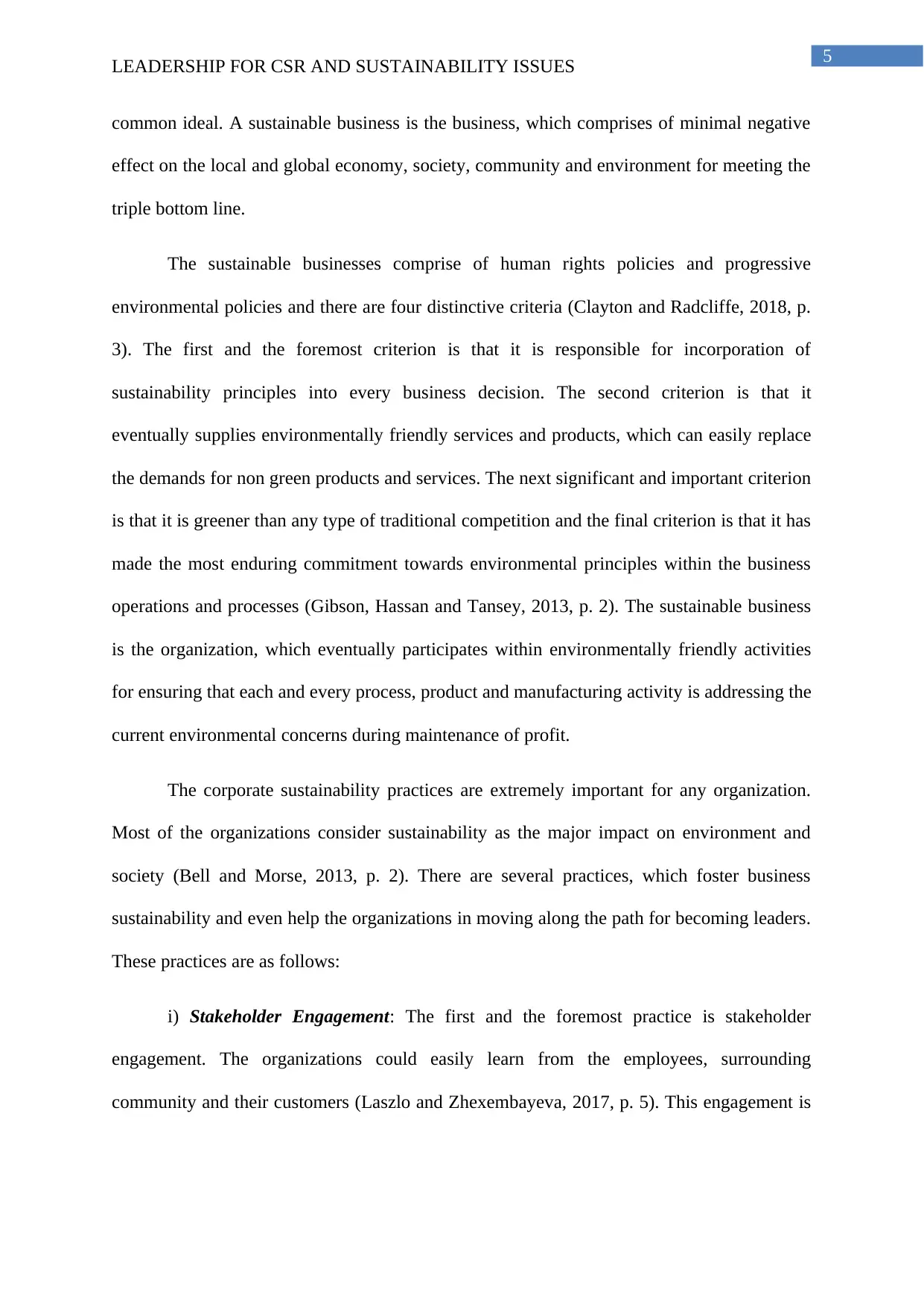
5
LEADERSHIP FOR CSR AND SUSTAINABILITY ISSUES
common ideal. A sustainable business is the business, which comprises of minimal negative
effect on the local and global economy, society, community and environment for meeting the
triple bottom line.
The sustainable businesses comprise of human rights policies and progressive
environmental policies and there are four distinctive criteria (Clayton and Radcliffe, 2018, p.
3). The first and the foremost criterion is that it is responsible for incorporation of
sustainability principles into every business decision. The second criterion is that it
eventually supplies environmentally friendly services and products, which can easily replace
the demands for non green products and services. The next significant and important criterion
is that it is greener than any type of traditional competition and the final criterion is that it has
made the most enduring commitment towards environmental principles within the business
operations and processes (Gibson, Hassan and Tansey, 2013, p. 2). The sustainable business
is the organization, which eventually participates within environmentally friendly activities
for ensuring that each and every process, product and manufacturing activity is addressing the
current environmental concerns during maintenance of profit.
The corporate sustainability practices are extremely important for any organization.
Most of the organizations consider sustainability as the major impact on environment and
society (Bell and Morse, 2013, p. 2). There are several practices, which foster business
sustainability and even help the organizations in moving along the path for becoming leaders.
These practices are as follows:
i) Stakeholder Engagement: The first and the foremost practice is stakeholder
engagement. The organizations could easily learn from the employees, surrounding
community and their customers (Laszlo and Zhexembayeva, 2017, p. 5). This engagement is
LEADERSHIP FOR CSR AND SUSTAINABILITY ISSUES
common ideal. A sustainable business is the business, which comprises of minimal negative
effect on the local and global economy, society, community and environment for meeting the
triple bottom line.
The sustainable businesses comprise of human rights policies and progressive
environmental policies and there are four distinctive criteria (Clayton and Radcliffe, 2018, p.
3). The first and the foremost criterion is that it is responsible for incorporation of
sustainability principles into every business decision. The second criterion is that it
eventually supplies environmentally friendly services and products, which can easily replace
the demands for non green products and services. The next significant and important criterion
is that it is greener than any type of traditional competition and the final criterion is that it has
made the most enduring commitment towards environmental principles within the business
operations and processes (Gibson, Hassan and Tansey, 2013, p. 2). The sustainable business
is the organization, which eventually participates within environmentally friendly activities
for ensuring that each and every process, product and manufacturing activity is addressing the
current environmental concerns during maintenance of profit.
The corporate sustainability practices are extremely important for any organization.
Most of the organizations consider sustainability as the major impact on environment and
society (Bell and Morse, 2013, p. 2). There are several practices, which foster business
sustainability and even help the organizations in moving along the path for becoming leaders.
These practices are as follows:
i) Stakeholder Engagement: The first and the foremost practice is stakeholder
engagement. The organizations could easily learn from the employees, surrounding
community and their customers (Laszlo and Zhexembayeva, 2017, p. 5). This engagement is
⊘ This is a preview!⊘
Do you want full access?
Subscribe today to unlock all pages.

Trusted by 1+ million students worldwide
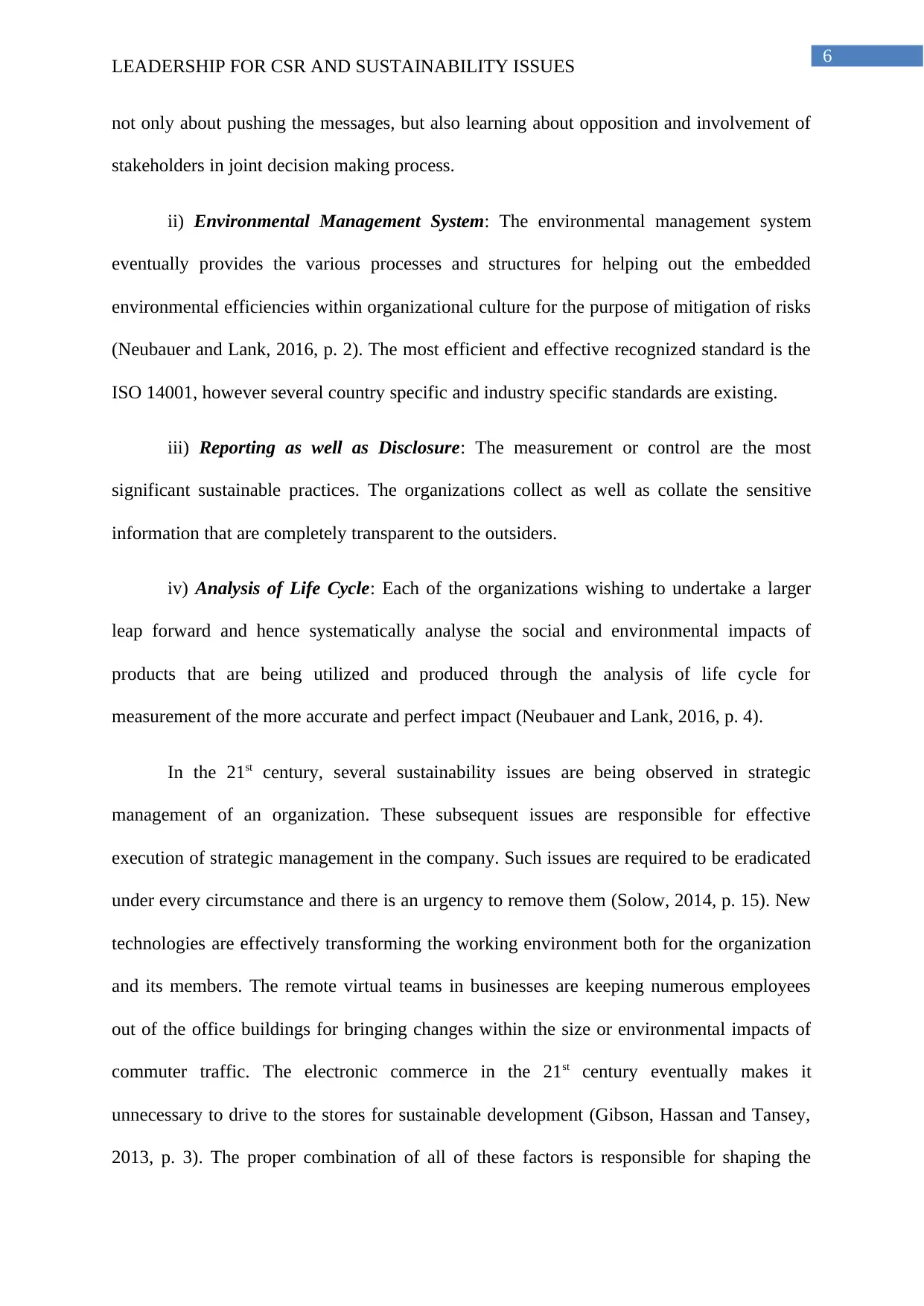
6
LEADERSHIP FOR CSR AND SUSTAINABILITY ISSUES
not only about pushing the messages, but also learning about opposition and involvement of
stakeholders in joint decision making process.
ii) Environmental Management System: The environmental management system
eventually provides the various processes and structures for helping out the embedded
environmental efficiencies within organizational culture for the purpose of mitigation of risks
(Neubauer and Lank, 2016, p. 2). The most efficient and effective recognized standard is the
ISO 14001, however several country specific and industry specific standards are existing.
iii) Reporting as well as Disclosure: The measurement or control are the most
significant sustainable practices. The organizations collect as well as collate the sensitive
information that are completely transparent to the outsiders.
iv) Analysis of Life Cycle: Each of the organizations wishing to undertake a larger
leap forward and hence systematically analyse the social and environmental impacts of
products that are being utilized and produced through the analysis of life cycle for
measurement of the more accurate and perfect impact (Neubauer and Lank, 2016, p. 4).
In the 21st century, several sustainability issues are being observed in strategic
management of an organization. These subsequent issues are responsible for effective
execution of strategic management in the company. Such issues are required to be eradicated
under every circumstance and there is an urgency to remove them (Solow, 2014, p. 15). New
technologies are effectively transforming the working environment both for the organization
and its members. The remote virtual teams in businesses are keeping numerous employees
out of the office buildings for bringing changes within the size or environmental impacts of
commuter traffic. The electronic commerce in the 21st century eventually makes it
unnecessary to drive to the stores for sustainable development (Gibson, Hassan and Tansey,
2013, p. 3). The proper combination of all of these factors is responsible for shaping the
LEADERSHIP FOR CSR AND SUSTAINABILITY ISSUES
not only about pushing the messages, but also learning about opposition and involvement of
stakeholders in joint decision making process.
ii) Environmental Management System: The environmental management system
eventually provides the various processes and structures for helping out the embedded
environmental efficiencies within organizational culture for the purpose of mitigation of risks
(Neubauer and Lank, 2016, p. 2). The most efficient and effective recognized standard is the
ISO 14001, however several country specific and industry specific standards are existing.
iii) Reporting as well as Disclosure: The measurement or control are the most
significant sustainable practices. The organizations collect as well as collate the sensitive
information that are completely transparent to the outsiders.
iv) Analysis of Life Cycle: Each of the organizations wishing to undertake a larger
leap forward and hence systematically analyse the social and environmental impacts of
products that are being utilized and produced through the analysis of life cycle for
measurement of the more accurate and perfect impact (Neubauer and Lank, 2016, p. 4).
In the 21st century, several sustainability issues are being observed in strategic
management of an organization. These subsequent issues are responsible for effective
execution of strategic management in the company. Such issues are required to be eradicated
under every circumstance and there is an urgency to remove them (Solow, 2014, p. 15). New
technologies are effectively transforming the working environment both for the organization
and its members. The remote virtual teams in businesses are keeping numerous employees
out of the office buildings for bringing changes within the size or environmental impacts of
commuter traffic. The electronic commerce in the 21st century eventually makes it
unnecessary to drive to the stores for sustainable development (Gibson, Hassan and Tansey,
2013, p. 3). The proper combination of all of these factors is responsible for shaping the
Paraphrase This Document
Need a fresh take? Get an instant paraphrase of this document with our AI Paraphraser
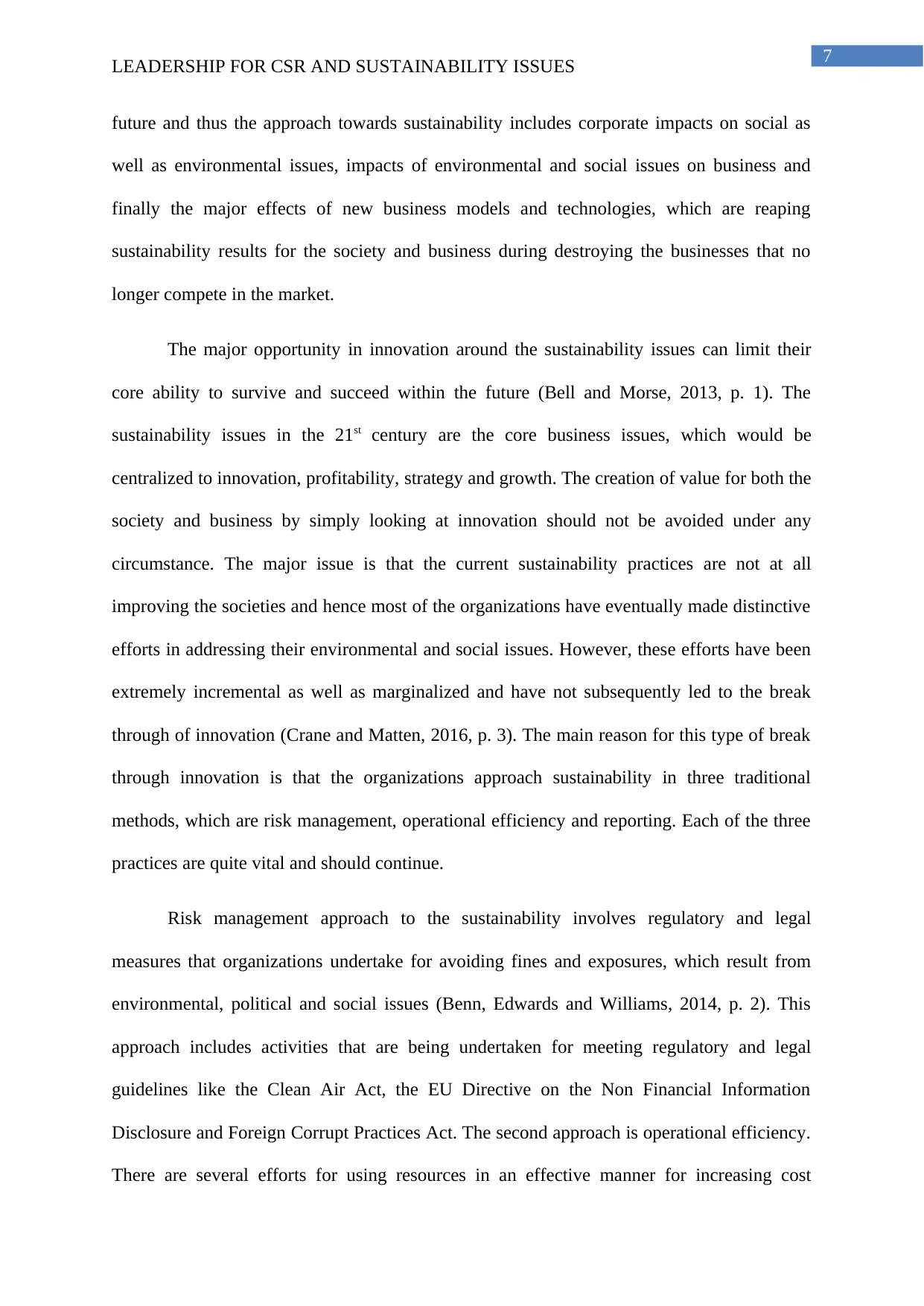
7
LEADERSHIP FOR CSR AND SUSTAINABILITY ISSUES
future and thus the approach towards sustainability includes corporate impacts on social as
well as environmental issues, impacts of environmental and social issues on business and
finally the major effects of new business models and technologies, which are reaping
sustainability results for the society and business during destroying the businesses that no
longer compete in the market.
The major opportunity in innovation around the sustainability issues can limit their
core ability to survive and succeed within the future (Bell and Morse, 2013, p. 1). The
sustainability issues in the 21st century are the core business issues, which would be
centralized to innovation, profitability, strategy and growth. The creation of value for both the
society and business by simply looking at innovation should not be avoided under any
circumstance. The major issue is that the current sustainability practices are not at all
improving the societies and hence most of the organizations have eventually made distinctive
efforts in addressing their environmental and social issues. However, these efforts have been
extremely incremental as well as marginalized and have not subsequently led to the break
through of innovation (Crane and Matten, 2016, p. 3). The main reason for this type of break
through innovation is that the organizations approach sustainability in three traditional
methods, which are risk management, operational efficiency and reporting. Each of the three
practices are quite vital and should continue.
Risk management approach to the sustainability involves regulatory and legal
measures that organizations undertake for avoiding fines and exposures, which result from
environmental, political and social issues (Benn, Edwards and Williams, 2014, p. 2). This
approach includes activities that are being undertaken for meeting regulatory and legal
guidelines like the Clean Air Act, the EU Directive on the Non Financial Information
Disclosure and Foreign Corrupt Practices Act. The second approach is operational efficiency.
There are several efforts for using resources in an effective manner for increasing cost
LEADERSHIP FOR CSR AND SUSTAINABILITY ISSUES
future and thus the approach towards sustainability includes corporate impacts on social as
well as environmental issues, impacts of environmental and social issues on business and
finally the major effects of new business models and technologies, which are reaping
sustainability results for the society and business during destroying the businesses that no
longer compete in the market.
The major opportunity in innovation around the sustainability issues can limit their
core ability to survive and succeed within the future (Bell and Morse, 2013, p. 1). The
sustainability issues in the 21st century are the core business issues, which would be
centralized to innovation, profitability, strategy and growth. The creation of value for both the
society and business by simply looking at innovation should not be avoided under any
circumstance. The major issue is that the current sustainability practices are not at all
improving the societies and hence most of the organizations have eventually made distinctive
efforts in addressing their environmental and social issues. However, these efforts have been
extremely incremental as well as marginalized and have not subsequently led to the break
through of innovation (Crane and Matten, 2016, p. 3). The main reason for this type of break
through innovation is that the organizations approach sustainability in three traditional
methods, which are risk management, operational efficiency and reporting. Each of the three
practices are quite vital and should continue.
Risk management approach to the sustainability involves regulatory and legal
measures that organizations undertake for avoiding fines and exposures, which result from
environmental, political and social issues (Benn, Edwards and Williams, 2014, p. 2). This
approach includes activities that are being undertaken for meeting regulatory and legal
guidelines like the Clean Air Act, the EU Directive on the Non Financial Information
Disclosure and Foreign Corrupt Practices Act. The second approach is operational efficiency.
There are several efforts for using resources in an effective manner for increasing cost
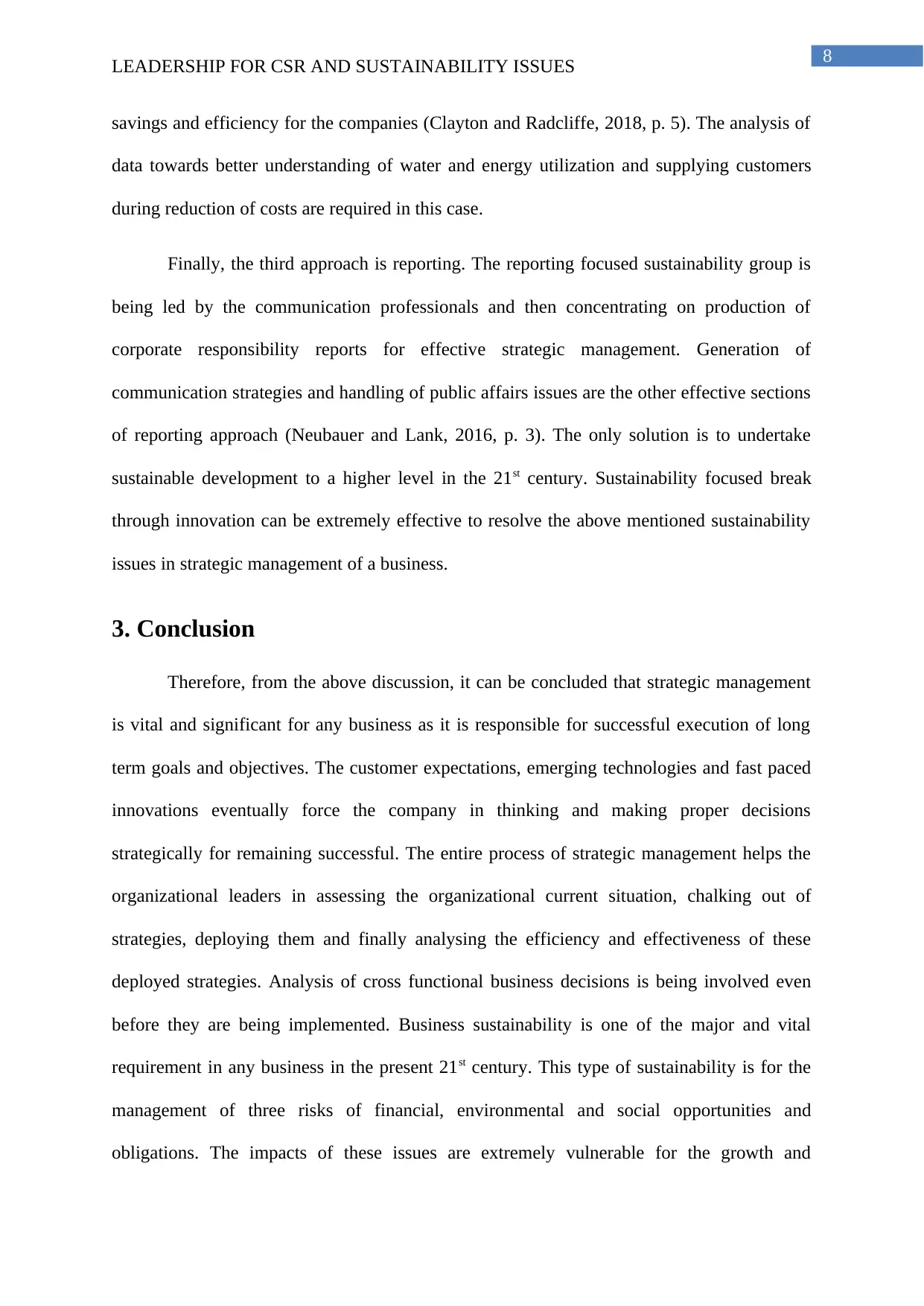
8
LEADERSHIP FOR CSR AND SUSTAINABILITY ISSUES
savings and efficiency for the companies (Clayton and Radcliffe, 2018, p. 5). The analysis of
data towards better understanding of water and energy utilization and supplying customers
during reduction of costs are required in this case.
Finally, the third approach is reporting. The reporting focused sustainability group is
being led by the communication professionals and then concentrating on production of
corporate responsibility reports for effective strategic management. Generation of
communication strategies and handling of public affairs issues are the other effective sections
of reporting approach (Neubauer and Lank, 2016, p. 3). The only solution is to undertake
sustainable development to a higher level in the 21st century. Sustainability focused break
through innovation can be extremely effective to resolve the above mentioned sustainability
issues in strategic management of a business.
3. Conclusion
Therefore, from the above discussion, it can be concluded that strategic management
is vital and significant for any business as it is responsible for successful execution of long
term goals and objectives. The customer expectations, emerging technologies and fast paced
innovations eventually force the company in thinking and making proper decisions
strategically for remaining successful. The entire process of strategic management helps the
organizational leaders in assessing the organizational current situation, chalking out of
strategies, deploying them and finally analysing the efficiency and effectiveness of these
deployed strategies. Analysis of cross functional business decisions is being involved even
before they are being implemented. Business sustainability is one of the major and vital
requirement in any business in the present 21st century. This type of sustainability is for the
management of three risks of financial, environmental and social opportunities and
obligations. The impacts of these issues are extremely vulnerable for the growth and
LEADERSHIP FOR CSR AND SUSTAINABILITY ISSUES
savings and efficiency for the companies (Clayton and Radcliffe, 2018, p. 5). The analysis of
data towards better understanding of water and energy utilization and supplying customers
during reduction of costs are required in this case.
Finally, the third approach is reporting. The reporting focused sustainability group is
being led by the communication professionals and then concentrating on production of
corporate responsibility reports for effective strategic management. Generation of
communication strategies and handling of public affairs issues are the other effective sections
of reporting approach (Neubauer and Lank, 2016, p. 3). The only solution is to undertake
sustainable development to a higher level in the 21st century. Sustainability focused break
through innovation can be extremely effective to resolve the above mentioned sustainability
issues in strategic management of a business.
3. Conclusion
Therefore, from the above discussion, it can be concluded that strategic management
is vital and significant for any business as it is responsible for successful execution of long
term goals and objectives. The customer expectations, emerging technologies and fast paced
innovations eventually force the company in thinking and making proper decisions
strategically for remaining successful. The entire process of strategic management helps the
organizational leaders in assessing the organizational current situation, chalking out of
strategies, deploying them and finally analysing the efficiency and effectiveness of these
deployed strategies. Analysis of cross functional business decisions is being involved even
before they are being implemented. Business sustainability is one of the major and vital
requirement in any business in the present 21st century. This type of sustainability is for the
management of three risks of financial, environmental and social opportunities and
obligations. The impacts of these issues are extremely vulnerable for the growth and
⊘ This is a preview!⊘
Do you want full access?
Subscribe today to unlock all pages.

Trusted by 1+ million students worldwide
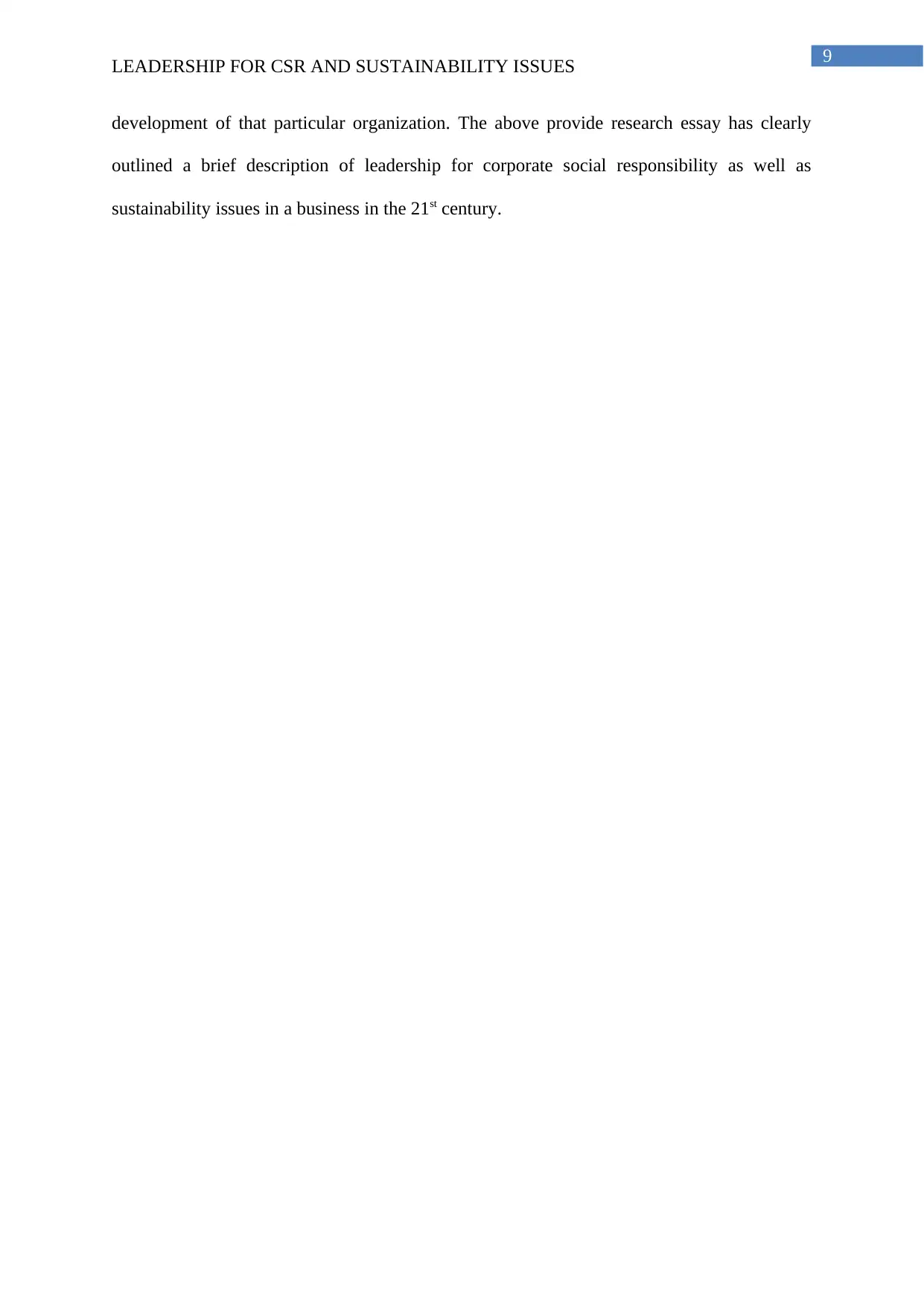
9
LEADERSHIP FOR CSR AND SUSTAINABILITY ISSUES
development of that particular organization. The above provide research essay has clearly
outlined a brief description of leadership for corporate social responsibility as well as
sustainability issues in a business in the 21st century.
LEADERSHIP FOR CSR AND SUSTAINABILITY ISSUES
development of that particular organization. The above provide research essay has clearly
outlined a brief description of leadership for corporate social responsibility as well as
sustainability issues in a business in the 21st century.
Paraphrase This Document
Need a fresh take? Get an instant paraphrase of this document with our AI Paraphraser
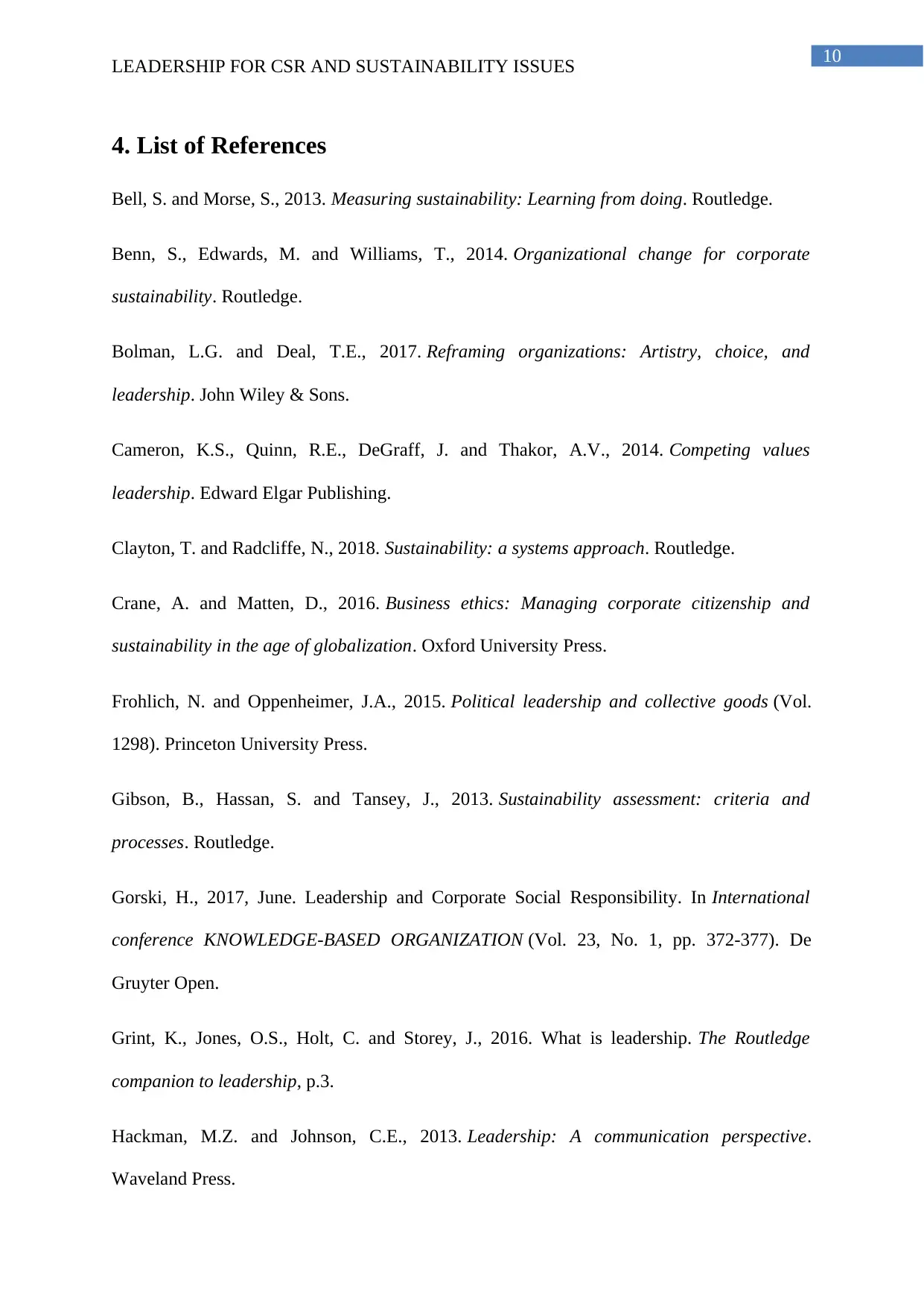
10
LEADERSHIP FOR CSR AND SUSTAINABILITY ISSUES
4. List of References
Bell, S. and Morse, S., 2013. Measuring sustainability: Learning from doing. Routledge.
Benn, S., Edwards, M. and Williams, T., 2014. Organizational change for corporate
sustainability. Routledge.
Bolman, L.G. and Deal, T.E., 2017. Reframing organizations: Artistry, choice, and
leadership. John Wiley & Sons.
Cameron, K.S., Quinn, R.E., DeGraff, J. and Thakor, A.V., 2014. Competing values
leadership. Edward Elgar Publishing.
Clayton, T. and Radcliffe, N., 2018. Sustainability: a systems approach. Routledge.
Crane, A. and Matten, D., 2016. Business ethics: Managing corporate citizenship and
sustainability in the age of globalization. Oxford University Press.
Frohlich, N. and Oppenheimer, J.A., 2015. Political leadership and collective goods (Vol.
1298). Princeton University Press.
Gibson, B., Hassan, S. and Tansey, J., 2013. Sustainability assessment: criteria and
processes. Routledge.
Gorski, H., 2017, June. Leadership and Corporate Social Responsibility. In International
conference KNOWLEDGE-BASED ORGANIZATION (Vol. 23, No. 1, pp. 372-377). De
Gruyter Open.
Grint, K., Jones, O.S., Holt, C. and Storey, J., 2016. What is leadership. The Routledge
companion to leadership, p.3.
Hackman, M.Z. and Johnson, C.E., 2013. Leadership: A communication perspective.
Waveland Press.
LEADERSHIP FOR CSR AND SUSTAINABILITY ISSUES
4. List of References
Bell, S. and Morse, S., 2013. Measuring sustainability: Learning from doing. Routledge.
Benn, S., Edwards, M. and Williams, T., 2014. Organizational change for corporate
sustainability. Routledge.
Bolman, L.G. and Deal, T.E., 2017. Reframing organizations: Artistry, choice, and
leadership. John Wiley & Sons.
Cameron, K.S., Quinn, R.E., DeGraff, J. and Thakor, A.V., 2014. Competing values
leadership. Edward Elgar Publishing.
Clayton, T. and Radcliffe, N., 2018. Sustainability: a systems approach. Routledge.
Crane, A. and Matten, D., 2016. Business ethics: Managing corporate citizenship and
sustainability in the age of globalization. Oxford University Press.
Frohlich, N. and Oppenheimer, J.A., 2015. Political leadership and collective goods (Vol.
1298). Princeton University Press.
Gibson, B., Hassan, S. and Tansey, J., 2013. Sustainability assessment: criteria and
processes. Routledge.
Gorski, H., 2017, June. Leadership and Corporate Social Responsibility. In International
conference KNOWLEDGE-BASED ORGANIZATION (Vol. 23, No. 1, pp. 372-377). De
Gruyter Open.
Grint, K., Jones, O.S., Holt, C. and Storey, J., 2016. What is leadership. The Routledge
companion to leadership, p.3.
Hackman, M.Z. and Johnson, C.E., 2013. Leadership: A communication perspective.
Waveland Press.
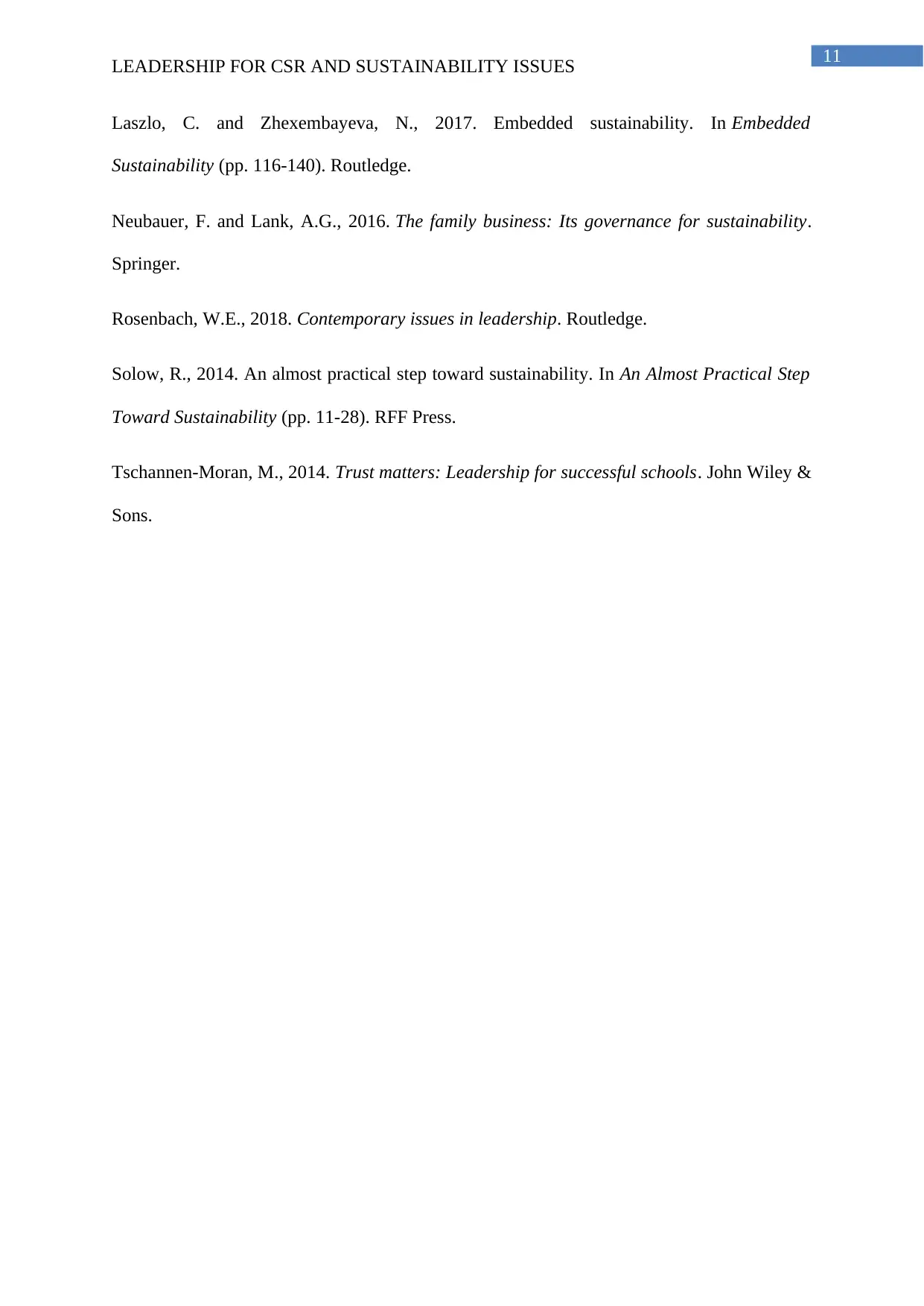
11
LEADERSHIP FOR CSR AND SUSTAINABILITY ISSUES
Laszlo, C. and Zhexembayeva, N., 2017. Embedded sustainability. In Embedded
Sustainability (pp. 116-140). Routledge.
Neubauer, F. and Lank, A.G., 2016. The family business: Its governance for sustainability.
Springer.
Rosenbach, W.E., 2018. Contemporary issues in leadership. Routledge.
Solow, R., 2014. An almost practical step toward sustainability. In An Almost Practical Step
Toward Sustainability (pp. 11-28). RFF Press.
Tschannen-Moran, M., 2014. Trust matters: Leadership for successful schools. John Wiley &
Sons.
LEADERSHIP FOR CSR AND SUSTAINABILITY ISSUES
Laszlo, C. and Zhexembayeva, N., 2017. Embedded sustainability. In Embedded
Sustainability (pp. 116-140). Routledge.
Neubauer, F. and Lank, A.G., 2016. The family business: Its governance for sustainability.
Springer.
Rosenbach, W.E., 2018. Contemporary issues in leadership. Routledge.
Solow, R., 2014. An almost practical step toward sustainability. In An Almost Practical Step
Toward Sustainability (pp. 11-28). RFF Press.
Tschannen-Moran, M., 2014. Trust matters: Leadership for successful schools. John Wiley &
Sons.
⊘ This is a preview!⊘
Do you want full access?
Subscribe today to unlock all pages.

Trusted by 1+ million students worldwide
1 out of 12
Related Documents
Your All-in-One AI-Powered Toolkit for Academic Success.
+13062052269
info@desklib.com
Available 24*7 on WhatsApp / Email
![[object Object]](/_next/static/media/star-bottom.7253800d.svg)
Unlock your academic potential
Copyright © 2020–2025 A2Z Services. All Rights Reserved. Developed and managed by ZUCOL.




